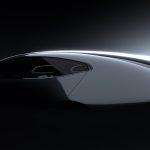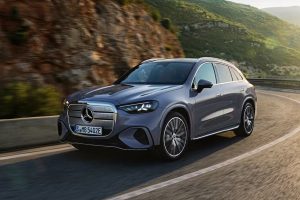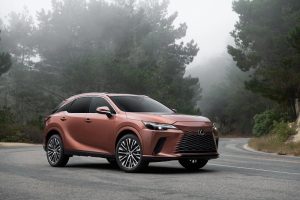With its latest Vision concept vehicle, Mercedes-Benz offers a retro-futuristic look at where it might take things with a coupe-style flagship that features not only an all-electric drivetrain but Level 4 hands-free driving capabilities. Headlight.News takes a closer look.
Mercedes-Benz dug deep into its past to come up with the latest in its long-running series of Vision concept vehicles.
With its improbably long hood and sculpted passenger compartment, Vision Iconic is a modern take on the pre-war grand tourers that helped position Mercedes as a symbol of European luxury. But it’s more than a retro exercise, adopting a modern take on the classic Mercedes grille and distinctly modern lighting.
It also features an all-electric drivetrain, Level 4 autonomous driving capabilities, and what the German automaker describes as neuromorphic computing.
What is the Vision Iconic
Making its debut in Shanghai, the Vision Iconic is the latest show car from Mercedes designed to both highlight its heritage and give viewers a sense of where the automaker’s future products may be heading. In this case, that touches on both future design directions and upcoming technology.
“Inspired by the golden era of automotive design of the 1930s, this show car embodies the pure essence of Mercedes-Benz,” said Gorden Wagener, chief design officer for Mercedes. “With its hood giving it a majestic presence, sculptural flowing lines and a touch of Art Deco, it rises to become a true icon of automotive beauty.”
But, in this case, the beauty is more than skin deep, added Markus Schäfer, the automaker’s chief technology officer. ““Vision Iconic embodies our vision for the future of mobility. With groundbreaking innovations such as neuromorphic computing, steer-by-wire, solar paint and Level 4 highly automated driving, along with state-of-the-art technology, we are setting new standards for the electric and digital age.”
Reimagining a familiar design
Low and sleek, with its long front end and windswept roof, Vision Iconic has a retro-futuristic look that “draws inspiration from the upright grilles of legendary models such as the W 108, W 111 and the Mercedes-Benz 600 Pullman,” Mercedes noted in a statement announcing the concept project.
But it also picks up on the new face of the brand previewed just last month with the debut of the all-electric Mercedes GLC, giving the grille a lattice structure with integrated lighting. The iconic tri-star itself rises above the hood but is here illuminated using modern LED technology. The lines of the 3-pointed star are carried over into the headlights.
Designed to be able to run entirely hands-free, the cabin undergoes a significant redesign compared to today’s Mercedes products, offering ways to keep driver and passengers occupied and entertained on long journeys. “The key highlight of the instrument panel is the “Zeppelin” floating glass structure,” notes Mercedes, “a sculptural form that reveals a captivating interior of artfully designed details and a refined interplay of analog and digital instruments.”
The Iconic show car continues to play with classic luxury touches, including its mother-of-pearl trim on the instrument and door panels, polished brass door handles, and a Mercedes-Benz logo that appear to
More Mercedes News
- First Look: Mercedes’ Vision V Limo Van
- Mercedes-AMG Sees Big Opportunities for Performance EVs
- Mercedes Bills the New CLA as a “Game-Changer”
All charged up
As with many of the recent Mercedes Vision concepts, Iconic draws power from an all-electric drivetrain – though the automaker has yet to provide specific details on the system.
One feature that might be overlooked by the casual viewer: the solar modules seamlessly integrated into the exterior surface of the show car as a wafer-thin paste, This approach could provide significant additional range for the electric drivetrain, according to Mercedes, depending upon where the owner were living and whether it had exposure to sunlight.
“For example, an area of 118 square feet (equivalent to the surface of a mid-size SUV) could produce energy for up to approximately 7,450 miles of range per year under ideal conditions,” the automaker said, “The coating does not contain any rare earths or silicon and can be easily recycled. The solar cells have a high efficiency of 20 percent and continuously generate energy – even when the vehicle is switched off.”
Neuromorphic computing
On some S-Class and EQS models, Mercedes today offers Level 3 autonomous driving technology. This allows a motorist to not only take their hands off the wheel but eyes off the road. However, speeds are limited to under 60 mph in Germany and 37 mph in the U.S. – and the motorist must be ready to take control in an emergency. The Iconic show car is designed to offer Level 4 autonomous driving which would function at virtually any speed and without driver intervention in most situations.
That technology not only requires much more advanced computing capabilities than currently offered on consumer vehicles, but it also draws a substantial amount of power.
And that’s where “neuromorphic computing” comes in, said Mercedes, which claims it is working on sensor and processing systems that “would be 10 times more efficient than current systems,” while also reducing energy requirements by 90%.
Vision Iconic capsule collection
Mercedes’ vision for the Iconic show car includes what the automaker calls its “capsule collection,” six specially designed outfits for men and women.
“With dark blue nuances and silver-gold accents, the outfits reflect the luxurious color scheme of Vision Iconic and play with the graphic elements of the show car’s interior,” the automaker explained. “The collection captures the essence of Art Deco by combining the lavish luxury of the 1920s and 1930s with the finest craftsmanship and exquisite materials.”
The capsule collection will make its debut alongside the Mercedes-Benz Vision Iconic which is being unveiled during the annual Shanghai Fashion Week.






0 Comments